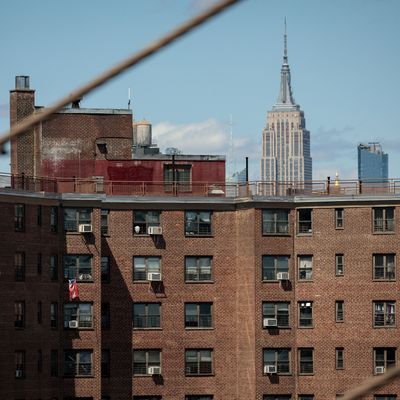
We’re committed to keeping our readers informed.
We’ve removed our paywall from essential coronavirus news stories. Become a subscriber to support our journalists. Subscribe now.
Even before New York became the epicenter of the pandemic, it didn’t take much imagination to project that COVID-19 would be a disaster for the roughly half-million people living in the city’s 326 public-housing complexes. A lethargic response from NYCHA, which does not appear to be tracking infection rates, has left residents and building staff to draw attention to the extent of the crisis. Last week, Politico reported on 27 deaths in three Brownsville, Brooklyn, NYCHA complexes, relying just on anecdotes of people who had died in their apartments — including a mother and son whose bodies were removed by the National Guard after neighbors reported the stench.
NYCHA’s 2,200 densely populated buildings, like MTA buses and subways, are probably virus hot spots. In mid-March, NYCHA said it would start disinfecting its senior buildings five times a week, and all other buildings three times a week. That doesn’t seem to be happening. On April 14, a NYCHA resident in Red Hook Houses sent me photos of her persistently dirty hallway, telling me she had yet to see anyone disinfect her building. Several days earlier, I heard much of the same on a conference call attended by dozens of NYCHA residents. Ditto from a tenant-association leader in the Bronx who was trying to clean his own complex. Eleven New York City congresspeople heard similar complaints from their constituents, prompting them to send a scathing April 7 letter to Housing Authority CEO Greg Russ.
One problem: Some of the same people responsible for keeping housing complexes clean may themselves have been sidelined by unsafe working conditions. While NYCHA has hired an outside contractor to disinfect high-touch areas, it is still relying on its on-site caretakers to clean the rest of its buildings. On March 19, Carl Giles sent an urgent email to NYCHA’s general manager, Vito Mustaciuolo, copying Russ and other senior officials. Giles is the housing director for Teamsters Local 237, the union that represents 8,000 frontline NYCHA employees (maintenance crews, roofers, exterminators, etc.). He reported that buildings did not have soap or paper towels for staffers; he added that workers were being supplied with a bio-detergent that was not in fact a disinfectant. Giles asked if there was a plan to quarantine employees who had been infected by the virus or worked with someone who had; and if NYCHA would set aside temporary apartments for employees, so they could cut down on commuting and better shelter in place.
On March 23, still awaiting a response, Giles sent another email to Mustaciuolo. He said his members were being asked to gather in close proximity for twice-daily musters with their supervisors. He said that building areas in which staffers had tested positive had not been disinfected until days after the infected parties left work. He reiterated that many buildings were still waiting on soap and paper-towel deliveries. “Staff is out there with nothing to help them fight against this virus,” he wrote. “Is it possible that locations purchase soap at the local stores until their deliveries come?”
On March 26, he still hadn’t received a response. So he sent another email, listing 34 developments without soap or paper towels.
On March 30, Giles got a response from an NYCHA employee. There was no protocol for quarantining employees exposed to COVID-19, nor for providing temporary residences for workers. The email did encourage symptomatic employees to stay home, and for everyone else to stay six feet apart during daily musters, which ideally would take place outdoors. Work areas occupied by infected individuals were to remain isolated until they were disinfected. According to the agency’s own inquiries, the employee wrote, “we have not been advised of locations identifying they have insufficient soap or paper towels.”
It took until April 2 for NYCHA, following the lead of the city’s Health Department, to recommend that employees wear face coverings, including when entering apartments for work orders. It took until April 7, two days after the City reported on NYCHA employees’ lack of protective equipment, for the Housing Authority to deliver its first shipment of ordinary surgical masks to staff. (The MTA first announced that it was distributing masks, including high-quality N95 respirators, on March 27.)
NYCHA spokesperson Barbara Brancaccio told me in an email that the agency has N100 respirators in reserve, but only for workers doing lead-paint-based or mold-removal jobs. When I asked her if the Housing Authority also had N95s in store — as Giles told me — she said, “We’ve provided you all the information we have at this time.”
Add it up — weeks of working without masks, soap, sanitizer — and many NYCHA employees are no longer coming to work. “On a daily basis,” Giles says, “I get 60 calls or emails from members who are sick.” Giles estimates that, between workers who are ill and who must stay home to care for their school-age children, the average development is down to half its usual staff. If on-site caretakers cannot, or will not, show up, the buildings probably aren’t going to stay safe.
On top of everything else, nobody seems to know how many NYCHA tenants, or employees, even have the virus. Which makes it hard to prioritize certain buildings for disinfecting, or alert members of the community to take extra precaution. On March 26, Russ and Mustaciuolo sent out a staffwide email mandating that supervisors alert NYCHA when an employee tested positive for the virus. At that point, they wrote, “the supervisor may then advise location employees of their potential exposure.” But when I asked Brancaccio if the agency was tracking workplace or tenant cases, she didn’t say. “Like residents, staff are not required to share their health status with NYCHA,” she wrote. I put the same question to the Health Department, and received no response.
On April 11, the New York Post published a tally of city-worker deaths, based on figures from unions and agencies. Fifty transit workers, 19 members of the NYPD, ten employees from the Department of Corrections. From NYCHA, it reported “no response.”






























